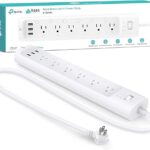Unlock the Power of Smart Plugs
Learn how to effortlessly monitor our energy consumption using smart plugs in just five simple steps! Embrace technology and make our homes more efficient.
What We Need to Get Started
Master Your Power: A Guide to Tracking Energy Usage Effectively
Step 1: Choose the Right Smart Plug
Not All Smart Plugs Are Created Equal!Identify smart plugs that cater to our energy tracking needs. Look for plugs with built-in energy monitoring capabilities. These will provide real-time insights into our energy usage.
Consider app compatibility as this will enhance our experience. Choose plugs that work seamlessly with apps like Google Home or Alexa for easier control.
Weigh the price against features. For instance, while some budget plugs might lack certain functionalities, investing in a feature-rich model can save us money in the long run. Review options and pick one that aligns with our lifestyle and budget.
Step 2: Set Up Your Smart Plug
A Few Clicks to a Smarter Home!Plug your smart plug into a wall outlet. Ensure it’s in a location that’s easily accessible for the devices you intend to connect.
Download the manufacturer’s app to your smartphone. Search for the app in your device’s app store and install it. For example, if we’re using a TP-Link plug, we’ll look for the Kasa Smart app.
Follow the in-app instructions to connect the plug to our Wi-Fi. This typically involves selecting our network and entering the Wi-Fi password.
Wait for the app to confirm a successful connection, and just like that, we’re ready for the next step!
Step 3: Connect Devices to Your Smart Plug
Transform Ordinary Devices into Smart Ones!Plug in our devices for monitoring. Start by taking the lamps, chargers, or any electronics we want to track.
Insert the device’s plug into the smart plug. For instance, if we’re monitoring a lamp, ensure its plug fits snugly into the smart plug.
Check the app for device recognition. Most smart plug apps will automatically detect the connected device. We might even be prompted to name it—for example, “Living Room Lamp”—which helps us easily track multiple devices.
With everything connected, we’re ready to move on!
Step 4: Monitor Your Energy Consumption
Data is Power—Literally!Open the app linked to our smart plug. Navigate to the dashboard to find energy consumption stats for our connected devices.
Select the device we want to track. For instance, if we’ve labeled our “Living Room Lamp,” tapping on it reveals daily and monthly usage trends.
Look for notable patterns. Are we noticing that our lamp uses more energy than expected during specific hours? This insight allows us to make informed decisions.
Set alerts for excessive use. Many apps let us customize notifications if a device exceeds a certain energy threshold, helping us stay proactive in managing our consumption.
Step 5: Optimize Your Energy Use
Save Money and the Planet—It's a Win-Win!Evaluate your consumption data regularly. After tracking our energy usage, let’s sit down and analyze the insights we’ve gained.
Identify energy hogs. For example, if our “Living Room Lamp” consumes significantly more energy during peak hours, we could consider using it less during those times or switching to LED bulbs.
Adjust habits accordingly. If we see that our phone charger is left plugged in overnight, let’s make it a habit to unplug it once our devices reach full charge.
Establish a schedule. Use the smart plug’s scheduling feature to power down devices automatically during non-use hours, like setting our TV to turn off at midnight.
These small changes can lead to noticeable savings on our energy bills and a lighter carbon footprint!
Start Your Energy Tracking Journey Today!
By following these five easy steps, we can take control of our energy consumption and make smarter choices for our homes. What changes will we implement first to reduce our footprint?



Leave a Reply